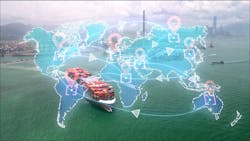We’ve learned a lot during the COVID-19 pandemic, but one ubiquitous underlying understanding that has resulted from this firsthand experience is that the world can be impacted in a very short period of time. And we—as individuals, as businesses, and as a culture—have to be agile and adept enough to react quickly.
The pandemic is a crisis that caused us to step back and rethink the way we interact and work as it affects public health and the economy. But it also serves as a great reminder that it is during times of disruption that some of the greatest innovations happen. For example, the electric razor, the car radio, and the very important chocolate chip cookie were all developed in the 1930s during the Great Depression. During World War II, the world was introduced to radar technology, penicillin, jet engines, and more.
See it Live at PACK EXPO Connects Nov. 9-13: On or Off the Pallet - Customized Robotic Solutions, by Brenton. Preview the Showroom Here.
In 2020, a decade that is dedicated to digitization, it is the supply chain that will be an area of innovation as a result of COVID-19 disruptions. That was the message that came out of a virtual symposium sponsored by Siemens Financial Services that focused on adapting the supply chain in an age of uncertainty. The speakers addressed how businesses can cope with unplanned global risks that threaten the future of societies, and how technology can help as we rethink our supply chain strategies.
According to Bruce McIndoe, president of McIndoe Risk Advisory, there are five megatrends that will shape the future of business and the world: globalization, demographics, climate change, resource scarcity, and technology innovation. Each are interlinked and influence global supply chains as the world supports a growing global population.
McIndoe briefly described these trends:
Globalization: As a result of an uncoupling movement between the U.S. and China and vulnerabilities in the global supply chain that the pandemic exposed, there will be a shift to deglobalization via onshoring or nearshoring.
Demographics: As we add two billion more people in the next 30 years, we’ll need more water, food, and housing to support them. It’s estimated that 80% of these new citizens will live in cities and by 2050 we’ll see cities with 50-to-100 million people. Based on urban density, growth of the middle class, and climate change, we’ll need to build an excess of 1 billion more housing units. “In the next 30 years, we essentially will need to rebuild the entire global housing stock since the beginning of mankind. That is a huge demand,” McIndoe said.
Climate change: This can ultimately become the weak link in the supply chain. The greater frequency and severity of climate hazards create more disruptions in the global supply chain by interrupting production, hampering transportation, raising prices, and ultimately hurting corporate profits.
Resource scarcity: Here, we are the issue—humans are massive consumers of natural resources, and by 2050 we will consume 140 billion tons of minerals, ore, fossil fuels, and biomass per year. That’s three times the current consumption rate. We must decouple economic growth from massive resource use, McIndoe said. In addition, water and food are life or death resources for all of us. Lack of access to water has been catalyst to war and will be a major driver for human migration—which creates friction and unrest. Lack of access to food, too, can drive people to be aggressive which can evolve into civil unrest.
Technology Innovations: The good news is, most of the solutions for long term human sustainability rely on technology innovations. Most of the technology we need for water, advanced farming, power generation, materials advancement, and modular recyclable materials, exist now or are in development.
See it Live at PACK EXPO Connects Nov. 9-13: Fast, Adjustable, Repeatable Guide Rail Changeover with NO Fine Tuning, by Septimatech Group Inc. Preview the Showroom Here.
And so there’s hope for the future, McIndoe said. “There’s no questions humankind will become more reliant on technology to sustain our population growth and raise the standard of living globally. And it is technology like robotics, artificial intelligence, and additive manufacturing that will make onshoring and nearshoring a reality for developed countries where labor costs are high,” he said.
He also said that access to always-on, high-speed broadband will change the nature of work—that is when and where work is done—as society eventually sheds its 9-to-5 work week tethered to the office. It is the pandemic that opened our eyes to the realization that many workers can be productive from home, and home can be anywhere on the planet.
Siemens USA CEO Barbara Humpton summed up what’s happening in the world right now in one word, “antifragility,” an idea explored in a book called Antifragile: Things That Gain From Disorder by Nassim Nicholas Taleb. The book describes how systems can increase in capability and thrive as a result of stressors, shocks, and volatility. It is the ability to respond, recover, and reinvent to get stronger from disruption. “We can experience antifragility during a crisis,” Humpton said. “We are looking for ways we can use today’s tools in different ways for a future that is more sustainable and resilient and more productive for all of us.”
See it Live at PACK EXPO Connects Nov. 9-13: Efficient Conveyor Systems Improve Workflow, by Nercon. Preview the Showroom Here.
Related Articles:COVID-19 Brings Increased Visibility to the Role of Robotics
Operations and Supply Chains After COVID-19
Preparing the Supply Chain for a Coronavirus Vaccine
The Potential of ERP Amid a Pandemic
PACK EXPO Connects – November 9-13. Now more than ever, packaging and processing professionals need solutions for a rapidly changing world, and the power of the PACK EXPO brand delivers the decision makers you need to reach. Attendee registration opens September 15. Be notified when the site goes live by clicking here.
Leaders relevant to this article:

